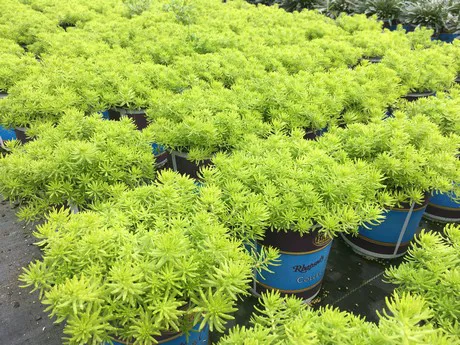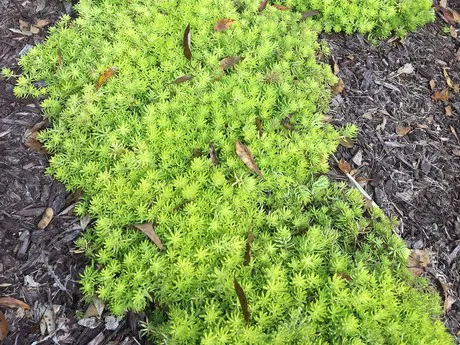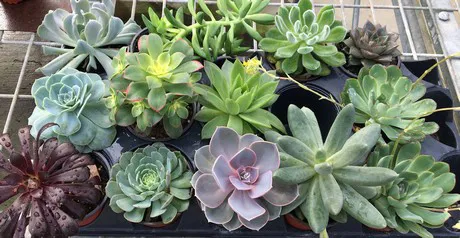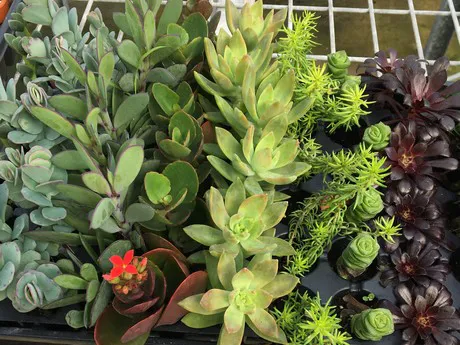The LSU AgCenter selected lemon sedum as a 2019 Louisiana Super Plant for many reasons, but mainly because of its effortless care and vigorous growth habit.
The color of this plant’s foliage is what makes it striking in the landscape next to other annuals and perennials. Lemon sedum is best grown in full sun, like cactus and other succulent plants, and it is both drought- and heat-tolerant.

Lemon sedum can be purchased in containers at nurseries and garden centers. LSU AgCenter file photo by Allen Owings
The Louisiana Super Plant program is an LSU AgCenter educational and marketing campaign that highlights tough and beautiful plants that perform well throughout the state of Louisiana. Each spring and fall, AgCenter horticulturists announce the Louisiana Super Plants selections for that year. Louisiana Super Plants have a proven track record with many years of reliable performance in Louisiana landscapes or have gone through several years of university evaluations and observations. Look for these plants at local nurseries.
Also known as stonecrop, sedums are one of the 50 to 60 families of succulent plants that display thick leaves in a variety of shapes, sizes, colors and characteristics. The distinctive leaves and stems of succulents can also have a waxy coating or a dense, hairy leaf coating that help to protect them from drying out in hot and dry climates where they are commonly found. Their specialized plant parts are adapted to retain water to help them survive. The water that is collected and stored by the plant is what causes the swollen, fleshy look of the different parts and contributes to why they stand out among other plants.

Lemon sedum can make an excellent ground cover. LSU AgCenter file photo by Allen Owings
Because they are adapted to dry soil conditions, sedums require well-drained soils for optimal growth in containers and in the landscape. Cactus, aloe vera and sedums are popular succulents used both indoors and outdoors in gardens and landscapes for their unique look.
Lemon sedum displays a fine-textured leaf that is more of a green color when grown in partial shade as opposed to the bright lime green or chartreuse color that it displays in full sun. The name has deceived home gardeners and growers. The plant does not have a lemon scent nor flavor but is simply called lemon due to its color.

A variety of sedum species can be found in nurseries and garden centers to use to create container gardens. Photo by Heather Kirk-Ballard/LSU AgCenter
In Louisiana, lemon sedum is treated as an annual, but it can be cold hardy and grow year-round in the warmer areas of the state. Its low relative height, spreading growth and mounding habit make it an excellent ground cover to grow over a large area quickly. Plants typically grow 3 to 6 inches in height and 12 to 24 inches in width. Spaced at 8 to 12 inches apart, they can cover a large area quickly as a ground cover.
It also has a spiller effect in containers and makes an excellent specimen for both hanging baskets and for cascading over the side of a retaining wall or rock wall. It is also an excellent choice as a bed border plant.

Sedums come in several forms with a variety of colors and shapes. Photo by Heather Kirk-Ballard/LSU AgCenter
New plantings are established with ease because the plant requires little soil to grow, and it can be effortlessly started on just a thin layer of soil among rocks or cracks in paved areas. For this reason, it has been used extensively in xeriscapes and rock gardens by homeowners and landscape professionals. It can also be easily propagated by using short cuttings or clippings and sprinkling them over tilled soil and then covering them lightly with a sandy soil mixture.
Sedums have become a trendy addition to the home and landscape for lots of folks. With the many different types available, sedums can be grouped or planted in masses for a striking display in the garden.
Local nurseries and commercial garden stores have a large variety of sedums to select from this time of year, and lemon sedum is readily available in the Baton Rouge area.
